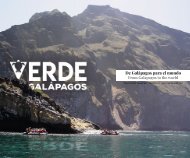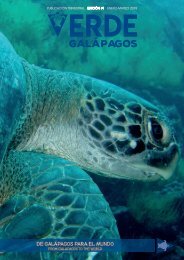Verde Galápagos #2
Te invitamos a leer nuestra segunda edición de la revista digital Verde Galápagos.
Te invitamos a leer nuestra segunda edición de la revista digital Verde Galápagos.
You also want an ePaper? Increase the reach of your titles
YUMPU automatically turns print PDFs into web optimized ePapers that Google loves.
verdE galápagos<br />
Piquero Patas Azules / Blue-fotted Booby :: Francisco “Pancho” Dousdebés<br />
años, el número de visitantes haciendo base<br />
en centros poblados ha sido mayor que el<br />
número de pasajeros a bordo de barcos de<br />
crucero. Esto ha fortalecido la economía local<br />
que se manifiesta en un imparable auge de<br />
la construcción y en la creciente cantidad de<br />
vehículos (algunos eléctricos) existentes. Sin<br />
embargo, la baja calidad de los servicios básicos<br />
deja entrever un aspecto social en desbalance.<br />
Con respecto al entorno, debemos aclarar<br />
que éste no son solamente las islas, sino todo<br />
el enorme capital y los procesos naturales que<br />
en ellas se expresan y se desarrollan, del cual<br />
los seres humanos disfrutamos y explotamos.<br />
Es preciso entender el socio-ecosistema como<br />
una entidad en la que interactuamos a diferentes<br />
niveles, no solo en los sitios de visita o<br />
los sitios de pesca. El manejo de este sistema<br />
en <strong>Galápagos</strong>, dentro de un sólido marco<br />
legal, tiene indicadores generales que lo<br />
presentan fuerte y saludable, pero un análisis<br />
más minucioso presenta un escenario mucho<br />
menos optimista: algunas especies endémicas<br />
en peligro de extinción debido a parásitos<br />
introducidos por el hombre, la fragmentación<br />
de hábitats críticos por cercas y caminos principales<br />
y vecinales, la no prohibición definitiva<br />
de artes de pesca, como el infame empate<br />
oceánico modificado.<br />
Todo eso, sumado al abandono del manejo de<br />
algunas fincas invadidas por plantas agresivas<br />
introducidas, al incremento de la demanda<br />
general de combustibles, alimentos, insumos<br />
de construcción y otros, que abren las puertas<br />
para la potencial introducción de organismos<br />
ajenos al archipiélago, al incremento de la basura,<br />
a la corrupción en el manejo de recursos<br />
y la débil conexión entre las agendas de los gobiernos<br />
autónomos descentralizados y las instituciones<br />
de conservación y manejo, nos dejan<br />
ante un panorama desalentador, pues dejan<br />
entrever que las necesidades presentes y futuras<br />
del entorno tampoco están garantizadas.<br />
En conclusión, el análisis de las causas y<br />
efectos del desarrollo actual de <strong>Galápagos</strong><br />
nos dice que éste no es sostenible y que hay<br />
mucho que trabajar al respecto.<br />
25<br />
tourism model: Is it possible to talk about<br />
Sustainable Development in the Galapagos<br />
Islands?<br />
The amount of people visiting the Galapagos<br />
Islands has been vigorously increasing<br />
for more than 30 years. It has<br />
gone from less than 10,000 to more than<br />
270,000 in 2018. In the last seven years, the<br />
number of visitors basing themselves in<br />
populated areas has surpassed the number<br />
of passengers onboard cruise ships.<br />
This has strengthened the local economy,<br />
which has led to a never-ending boom in<br />
construction and in the increasing of the<br />
vehicle fleet, which also includes electric<br />
cars. Despite this, the poor level of basic<br />
services like electricity and water results in<br />
an unbalanced social aspect.<br />
Regarding the environment, it is important<br />
to say that it includes more than just the<br />
Islands; it is comprised of the enormous<br />
capital and natural processes that are expressed<br />
and developed within and that<br />
we humans enjoy and exploit. It is precise<br />
to understand the socio-ecosystem as<br />
an entity in which we interact at different<br />
levels, not only for the visiting sites and<br />
fishing areas. The management of the<br />
socio-ecosystem, within a solid legal<br />
framework, has general indicators that<br />
show its strength and health; However, a<br />
more thorough analysis reveals a less optimistic<br />
scene: Some endemic species are<br />
in danger of extinction due to parasites<br />
introduced by man; Critical habitats have<br />
been fragmented by fences and main<br />
and secondary roads; The lack of outlawing<br />
of some destructive fishing methods,<br />
like trawling, has been a way of depleting<br />
certain fish species. All of this, added to<br />
the abandoning of certain farms due to<br />
the overwhelming invasion of introduced<br />
aggressive plants; the increasing general<br />
demand for fuel, food, construction supplies,<br />
and other items have opened the doors<br />
to the potential introduction of organisms<br />
foreign to the archipelago. The increasing<br />
amount of garbage, the corruption present<br />
in the management of resources, and<br />
the weak connection between the agendas<br />
of the local government and the conservation<br />
institutions all leave us before a<br />
discouraging landscape. This also allows<br />
us to acknowledge that there is no guarantee<br />
that the current and future needs<br />
of the environment will be covered.<br />
In conclusion, the analysis of the causes<br />
and effects of the current development of<br />
The Galapagos Islands tells us that they<br />
are not, in fact, sustainable and that there<br />
is much work to be done.





